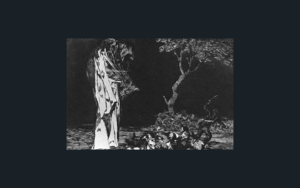Madness in Dostoevsky

Interpreting Psychological Disorders As They Appear In Dostoevsky:
Madness is a common theme found in several of Dostoevsky’s novels and novellas including The Double, Crime and Punishment, The Brothers Karamazov, Notes From The Underground, and The Idiot. For example, Nastasya Filippovna, Raskolnikov, Golyadkin, and Ivan Karamazov are described as mad to some extent, and even the characters themselves judge other characters to be mad: “She’s mad—she’s mad!” (The Idiot, Part 1, Chapter 16). Although Baktin argued that “Dostoevsky did not consider himself a psychologist in any sense of the term,” nonetheless, he wrote many psychologically complex characters (Bakhtin quoted in Joshua Pederson, 79). According to Yuri Corrigan, “Dostoevsky’s preoccupation with the wounds of the mind began in the mid-1840s” (Corrigan, 393). Some common psychological questions that arise from Dostoevsky’s works include discussions about insanity or psychosis, amnesia, social isolation, suicide, and trauma, among others (Corrigan, 401; Burry, 258; Pederson, 84; de Macedo, 16-19, 110; Ronner, 121-129). It is therefore helpful to understand how some “wounds of the mind” can be categorized or understood as disorders or conditions (Corrigan, 393). By definition, the hallmark of a psychological disorder is that it affects ones “thoughts, feelings, and/or behaviours,” causes “distress” to the person with the disorder, and that it goes beyond societal norms, cultural and/or religious beliefs (American Psychiatric Association, What is Mental Illness?). Thus, this is a helpful paradigm from which one can interpret the actions of Dostoevsky’s characters because many characters are described as having behaviours that meet this definition. For instance, Golyadkin sees many Golyadkins: “an unending series of precisely similar Golyadkins were noisily bursting in at every door of the room,” which is a perception that causes him distress and goes beyond cultural beliefs about what is possible (The Double, 132). Even if one does not find that the actions of the characters correspond to a definable disorder in the modern sense, these psychological questions are still worth contemplating. Conversely, some scholars have used Dostoevsky’s works to provide insights into psychology. Burry is a notable example of this as he has argued that one of the greatest psychological insights that can be gained from Dostoevsky is to understand trauma and he states that, “The Idiot creates what could be considered a ‘post-traumatic’ chronotope, which accompanies the novel’s broader apocalyptic outline” (Burry, 258).
It is important to note, however, that some scholars have cautioned against utilizing some psychological approaches. For example, de Macedo discourages interpreting passages that describe characters like the Underground Man according to a psychoanalytic perspective: “we would be wrong to interpret this torment as a defence mechanism constructed by an obsessive personality, as psychoanalytic practice teaches us” (de Macedo, 16). Without trying to name a disorder, Joshua Pederson examines the implications of “Raskolnikov’s central ideas in the essay: that crime makes a perpetrator sick,” but also the role of Sonya as an solution to that sickness, “Sonya is the character most responsible for Raskolnikov’s promising if incomplete psychological rehabilitation” (Pederson, Moral Injury and Moral Repair in Crime and Punishment, 80). Pederson further analyzes Raskolnikov, “[s]peaking with Sonya, he worries that she too will both become totally isolated and begin to suffer psychologically: ‘[I]f you remain alone,’ he pleads with her, 'you’ll lose your mind, like me’” (Pederson, Moral Injury and Moral Repair in Crime and Punishment, 84). Several scholars have sought to analyze Dostoevsky’s characters form a psychological perspective, and while there can be limitations to these approaches, there are also many merits.
Works Cited:
American Psychiatric Association. “What is Mental Illness?” psychiatry.org 2021, https://www.psychiatry.org/patients-families/what-is-mental-illness
Burry, Alexander. “Execution, Trauma, and Recovery in Dostoevsky’s ‘The Idiot.’” The Slavic and East European Journal, vol. 54, no. 2, 2010, pp. 255-271. https://www.jstor.org/stable/41430444
Corrigan, Yuri. “Donna Tartt’s Dostoevsky: Trauma and the Displaced Self.” Comparative Literature vol. 70, no. 4, 2018, pp. 392–407. doi: https://doi-org.eu1.proxy.openathens.net/10.1215/00104124-7215462
de Macedo, Heitor O'Dwyer. Clinical Lessons on Life and Madness: Dostoevsky's Characters. Routledge, Milton, 2018, doi:10.4324/9781351014557.
Dostoevsky, Fyodor. The Idiot. Translated by Eva Martin, Ebook, 2001.
Dostoevsky, Fyodor. The Double. Translated by Constance Garnett, Dover Publications Inc., 1997.
Goya, Francisco. La Locura Del Miedo. 1819-1823. Wikiart: Visual Art Encyclopedia. https://www.wikiart.org/en/francisco-goya/the-madness-of-fear
Pederson, Joshua. Sin Sick: Moral Injury in War and Literature. Cornell University Press, Ithaca, 2021.
Ronner, Amy D., Dostoevsky as Suicidologist: Self- Destruction and the Creative Process. Lexington Books, Lanham, 2021.
The American Psychiatric Association (APA) Definition. 17 Nov. 2020, https://socialsci.libretexts.org/@go/page/77076.